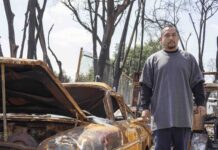
As the son of a journalist, Christopher Reynolds became interested in storytelling when two of his friends took him to the paste-up room for Fresno State’s student newspaper on their way to a party.
By the time he graduated in 1982, Reynolds had already logged two years as a reporter for the Fresno Bee, followed by seven years at the San Diego Union before heading to the LA Times.
But it was several trips he took in his 20s around the world that led to his current career as a travel writer who frequently takes photos for his assignments.
Since 2015, Reynolds said he has “kayaked in Canada, surfed in San Diego, snorkeled in American Samoa, floated in Xochimilco in Mexico, climbed the hills of Dingle, Ireland and swallowed twitching seafood in Seoul.”
“I realized that as much as I loved storytelling, I really like being able to incorporate photographs into the storytelling,” Reynolds said.
Reynolds said his best travel assignment was when he went to small towns across the United States to write stories and take pictures, including Oxford, Miss., Williamstown, Mass., Homer, Alaska, and Sheridan, Wyo. He spent several days in each town interviewing locals.
Traveling and listening has helped him understand people and recognize what is important in a story.
Los Angeles Times photo editor Taylor Arthur has been working with Reynolds for over five years on the travel and lifestyle sections of the Times. “The first thing I learn about Chris is that he never goes out to report on his stories without his camera.” Arthur said. “Even if we assign a staff photographer to go with him, the camera is still always on him.”
Like Reynolds, Arthur believes the most rewarding thing about photography is storytelling and connecting with communities. She said there is a trend of using people in pictures to show more experiences instead of just a plate of food or a place.
“As a photographer, you have to understand, have some connection to the community or at least be comfortable with being vulnerable,” Arthur said.
Reynolds said he makes a practice of talking to locals to build trust while on travel photography trips. Nearly 25 years ago, he got invited to join a cultural exchange trip to the Ivory Coast in West Africa. He embedded himself in the group on the trip and earned their trust to tell their story as well as possible.
“By the end of the trip, I had people showing me their diary entries, and I’d made some friends that I held onto for a long time. It was a really rewarding trip,” Reynolds said.
Professional freelance photographer Mark Edward Harris said research is a key to successful travel assignments. Known for his photography books on North Korea, he has visited the country 10 times. Before his first visit, Harris researched the history of the region and the war that split Korea in two to understand the land and people who live there.

Harris also mentioned social media is an important way for people to see your work and hire you to take pictures.
“It’s a free advertising tool,” Harris said. “Unfortunately, now, a lot of public relations companies, they just look at your social media numbers. They don’t look at, ‘Oh, my God. He’s been published in Vanity Fair, Newsweek, TIME, everybody, right?’”
But technology has changed the industry. Once the smartphone was invented fewer clients wanted to pay for pictures because they can take good photos on their own.
“It’s easier to get great pictures, but it’s harder to get paid for them,” Reynolds said.

Regardless of technological changes, Reynolds said understanding people better is what’s important. He tells young reporters not to make everything “make-or-break” when taking photos or writing a story.
“If you’re showing your humanity and coming to a better understanding of the person or people that you’re with, it’s probably going to lead to a better opportunity for an image or for quotes,” Reynolds said.



